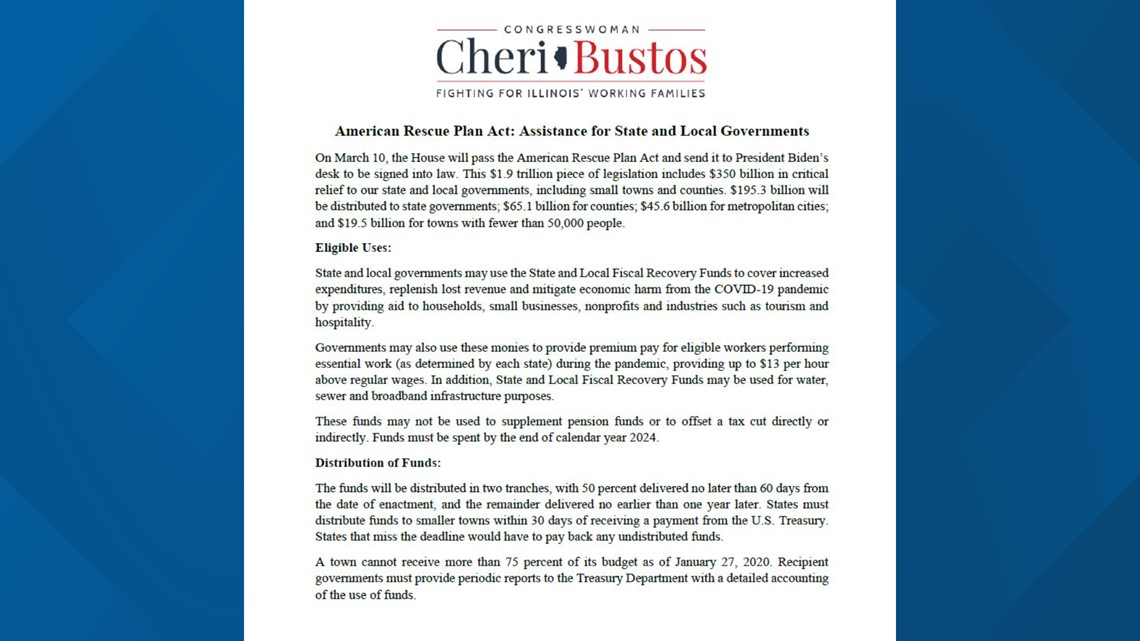MOLINE, Ill. — The Federal Government Passed the American Rescue Plan a week ago. But questions still remain. Such as, "Why does my local government need money?" Some critics believe the $350 billion set aside for local and state governments is used to bail out counties with unbalanced budgets. News 8's David Bohlman spoke with Rock Island County, Illinois and Scott County, Iowa to find out the truth of where this money is going, and how it could affect you.
The Government has set aside:
- $27 million for Rock Island County, Illinois
- $33.5 million for Scott County, Iowa
But this money isn't a free-for-all. The Federal Government has set aside strict guidelines on how this money can be spent.
What can local and state governments do with the money set aside for them?
State and local governments may use the State and Local Fiscal Recovery Funds to cover increased expenditures, replenish lost revenue and mitigate economic harm from the COVID-19 pandemic by providing aid to households, small businesses, nonprofits and industries such as tourism and hospitality.
Governments may also use these monies to provide premium pay for eligible workers performing essential work (as determined by each state) during the pandemic, providing up to $13 per hour above regular wages. In addition, State and Local Fiscal Recovery Funds may be used for water, sewer and broadband infrastructure purposes.
These funds may not be used to supplement pension funds or to offset a tax cut directly or indirectly. Funds must be spent by the end of calendar year 2024.
-Press Release from Congresswoman Cheri Bustos


What sort of a revenue loss is my county facing?
According to David Farmer, Scott County Iowa Director of Budget and Administrative Services, "Over the past year [Scott County] probably had a $1 million loss of revenue".
Those losses are credited back to areas like:
- Charges for services related to conservation (Scott County Parks and Recreation)
- Scott County holds money for various entities and normally receives income from interest but those dollars were down.
- Fees and Charges from services like the annual tax sale on delinquent taxes.
Rock Island County has seen a loss of revenue somewhere in the ballpark of $3 million dollars according to Jim Snider, County Administrator. "We definitely have seen a several million dollar reduction year over year and our revenue stream for sales tax, corporate tax, income tax".
But the money that has been set aside for local and state governments doesn't just show up in their bank accounts. While the Federal Government has set aside lump sums of money, local counties still need to apply to the Treasury in order to obtain those funds. The counties are then on the hook for tracking every dollar to be sure there was no misuse taking place.
So is this just a bailout for counties with unbalanced budgets?
Yes, and No, The counties have to follow the guidelines set forth by the Federal Government. As long as the monies are being put toward areas approved by the Federal Government the county can use the funds for whatever they see fit.
Does my county actually need the help?
Jim Snider with Rock Island County says, "There is no doubt again if one would look back at the last 3 budget years we've been getting by, by the skin of our teeth. We deferred a lot of capital and we delayed a lot of hiring... if we hadn't received this there's no doubt with our revenue stream being what they are that we would definitely be laying people off and getting further into a hole by not being able to fund capital."
David Farmer with Scott County says: "We do a balanced budget each year so if we have a shortfall in one of those categories it normally comes out of positive revenue variances in another category or our fund balance equity which is income carried over from one year to the next, kind of like a savings account. We have a healthy reserve just for this intended purpose. In case there are any budgetary shortfalls".
This $1.9 trillion piece of legislation includes $350 billion in relief to state and local governments. $195.3 billion will be distributed to state governments; $65.1 billion for counties; $45.6 billion for metropolitan cities; and $19.5 billion for towns with fewer than 50,000 people.

